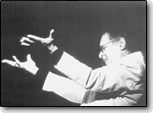|
Born 1923 in Cincinnati,Ohio, George Russell is a hugely influential, innovative figure in the evolution of contemporary jazz, and one of America's greatest living composers.

Russell was the adopted son of a registered nurse and a chef on the B&O Railroad. He began playing drums with the Boy Scout Drum and Bugle Corps and eventually received a scholarship to Wilberforce University where he joined the Collegians, whose list of alumni include Coleman Hawkins, Benny Carter, Fletcher Henderson, Ben Webster, Cootie Williams, Ernie Wilkins and Frank Foster. But his most valuable musical education came in 1941, when, in attempting to enlist in the Marines, he was diagnosed with tuberculosis, spending 6 months in the hospital where he was taught the fundamentals of harmony from a fellow patient. From the hospital he sold his first work, "New World," to Benny Carter. He joined Benny Carter's Band, but was replaced by Max Roach; after Russell heard Roach, he decided to give up drumming. He moved to New York where he was part of a group of musicians who gathered in the basement apartment of Gil Evans. The circle included Miles Davis, Gerry Mulligan, Max Roach, Johnny Carisi and on occasion, Charlie Parker. He was commissioned to write a piece for Dizzy Gillespie's orchestra; the result was the seminal "Cubano Be/Cubano Bop" the first fusion of Afro-Cuban rhythms with jazz, premiered at Carnegie Hall in 1947 and featuring Chano Pozo. Two years later his "Bird in Igor's Yard" was recorded by Buddy DeFranco, a piece notable for its fusion of elements from Charlie Parker and Stravinsky.

It was a remark made by Miles Davis when George asked him his musical aim which set Russell on the course which has been his life. Miles said he "wanted to learn all the changes." Since Miles obviously knew all the changes, Russell surmised that what he meant was he wanted to learn a new way to relate to chords. This began a quest for Russell, and again hospitalized for 16 months, he began to develop his "Lydian Chromatic Concept of Tonal Organization." First published in 1953, the Lydian Concept is credited with opening the way into modal music, as demonstrated by Miles in his seminal "Kind of Blue" recording. Using the Lydian Scale as the PRIMARY SCALE of Western music, the Lydian Chromatic Concept introduced the idea of chord/scale unity. It was the first theory to explore the vertical relationship between chords and scales, and was the only original theory to come from jazz.
Click here to visit www. GeorgeRussell.com for more information on George Russell and his Living Time Orchestra.
Among Russell's awards are the John D and Catherine T. Macarthur Fellowship, the National Endowment for the Arts American Jazz Master, two Guggenheim Fellowships, eight awards from the National Endowment for the Arts, and election as a Foreign Member of the Royal Swedish Academy.
|

